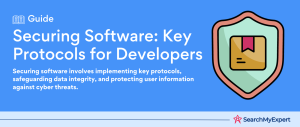The Importance of Secure Coding in Software Development
In today’s interconnected world, software security is more critical than ever. With the increasing reliance on software for everything from managing finances to controlling critical infrastructure, the potential consequences of software vulnerabilities are far-reaching. Secure coding practices are essential for developing software that is resistant to attack and protects sensitive data.
The Costs of Insecure Software
Insecure software can have a devastating impact on individuals, businesses, and organizations. The costs of insecure software include:
- Financial losses: Data breaches, ransomware attacks, and other cyberattacks can result in significant financial losses for businesses and organizations. In addition to the direct costs of remediation, businesses may also face lost revenue, legal fees, and damage to their reputation.
- Loss of data and privacy:
Data breaches can expose sensitive personal information, such as financial data, medical records, and social security numbers. This can lead to identity theft, fraud, and other harm. - Disruption of operations:
Cyberattacks can disrupt business operations, leading to downtime, lost productivity, and customer dissatisfaction. In severe cases, cyberattacks can even cause physical damage to critical infrastructure.
The Benefits of Secure Coding
Adopting secure coding practices can help organizations avoid the costs and risks associated with insecure software. The benefits of secure coding include:
- Reduced risk of cyberattacks:
Secure coding practices help to identify and eliminate vulnerabilities that could be exploited by attackers. This can help to prevent data breaches, ransomware attacks, and other cyberattacks. - Protection of sensitive data:
Secure coding practices help to protect sensitive data from unauthorized access, modification, or destruction. This can help to safeguard personal information, financial data, and other confidential information. - Improved software quality: Secure coding practices can help to improve the overall quality of software by reducing the number of bugs and vulnerabilities. This can lead to more reliable and maintainable software.
Secure Coding Principles
Secure coding principles are guidelines that help developers write code that is resistant to attack. These principles are based on the understanding of how software vulnerabilities are exploited and how to prevent them.
Here are some of the key secure coding principles:
- Defense in depth:
Employ multiple layers of security to protect against attacks. This means using a variety of security controls, such as input validation, access control, and encryption, to make it more difficult for attackers to compromise a system. - Fail-safe defaults: Configure systems to be secure by default. This means that if a security setting is not explicitly configured, the system should be in a secure state.
- Least privilege:
Grant users only the permissions they need to perform their job functions. This helps to limit the potential damage that an attacker can do if they compromise a user’s account. - Separation of concerns: Divide code into modules with well-defined boundaries. This helps to isolate vulnerabilities and prevent them from spreading to other parts of the code.
- Complete mediation: Check all inputs and outputs for security vulnerabilities. This includes validating user input, encoding output, and sanitizing data.
- Timeliness: Respond to security incidents promptly and effectively. This includes having a plan for incident response and a process for patching vulnerabilities.
- Economy of mechanism: Keep security mechanisms simple and easy to understand. This helps to reduce the risk of introducing new vulnerabilities.
- Simplicity: Keep code as simple as possible. This makes it easier to understand and maintain, and it also reduces the likelihood of introducing vulnerabilities.
- Open design: Design systems to be open and transparent. This allows for security reviews and independent testing.
- Fail-safe failure: Ensure that systems fail in a secure way. This means that a system should not crash or become unusable if a security vulnerability is exploited.
- Conservation of resources:
Use resources efficiently to avoid creating vulnerabilities. This includes minimizing the amount of code that is written and using secure coding libraries and frameworks. - Least astonishment: Make sure that the behavior of the code is predictable and does not surprise users. This helps to prevent users from making mistakes that could lead to security vulnerabilities.
- Reflection:
Regularly review and update secure coding practices to reflect new threats and vulnerabilities.
Secure Coding Practices
Secure coding practices are specific techniques that developers can use to implement secure coding principles. These practices are based on the understanding of how common software vulnerabilities are exploited and how to prevent them.
Here are some of the key secure coding practices:
Input Validation
Input validation is the process of checking all user-supplied input for security vulnerabilities. This includes checking for invalid data types, cross-site scripting (XSS), and SQL injection (SQLi).
Output Encoding
Output encoding is the process of converting data into a format that is safe to display or transmit. This includes encoding HTML entities, URLs, and other potentially dangerous characters.
Authentication and Password Management
Authentication is the process of verifying a user’s identity. Password management is the process of creating, storing, and using passwords securely.
Session Management
Session management is the process of tracking a user’s identity and state during a session. This includes creating, maintaining, and destroying sessions.
Access Control
Access control is the process of restricting access to resources based on a user’s identity and permissions. This includes using role-based access control (RBAC), attribute-based access control (ABAC), and other access control models.
Cryptographic Practices
Cryptographic practices are the use of encryption and other cryptographic techniques to protect sensitive data. This includes encrypting data at rest and in transit, using strong encryption algorithms, and using digital signatures.
Error Handling and Logging
Error handling is the process of dealing with errors in a way that does not compromise security. Logging is the process of recording events and messages in a system log.
Security Testing
Security testing is the process of testing software for security vulnerabilities. This includes static application security testing (SAST), dynamic application security testing (DAST), and penetration testing.
Secure Deployment
Secure deployment is the process of deploying software in a secure way. This includes configuring systems securely, using security patches, and monitoring systems for security vulnerabilities.
Conclusion
Secure coding is an essential part of the software development lifecycle. It is a proactive approach to software security that helps to prevent vulnerabilities from being introduced in the first place. Secure coding practices are based on well-established security principles and can be applied to different types of software. Security testing is an important part of the secure coding process to identify and fix any vulnerabilities that may be present. Secure deployment is also essential to protect software from attack.
By adopting secure coding practices, organizations can reduce the risk of cyberattacks, protect sensitive data, and improve the overall quality of their software. This is an investment that will pay off in the long run.
Discover a hub of innovation with Software Development companies that redefine what’s possible!
Table of Contents
Toggle






